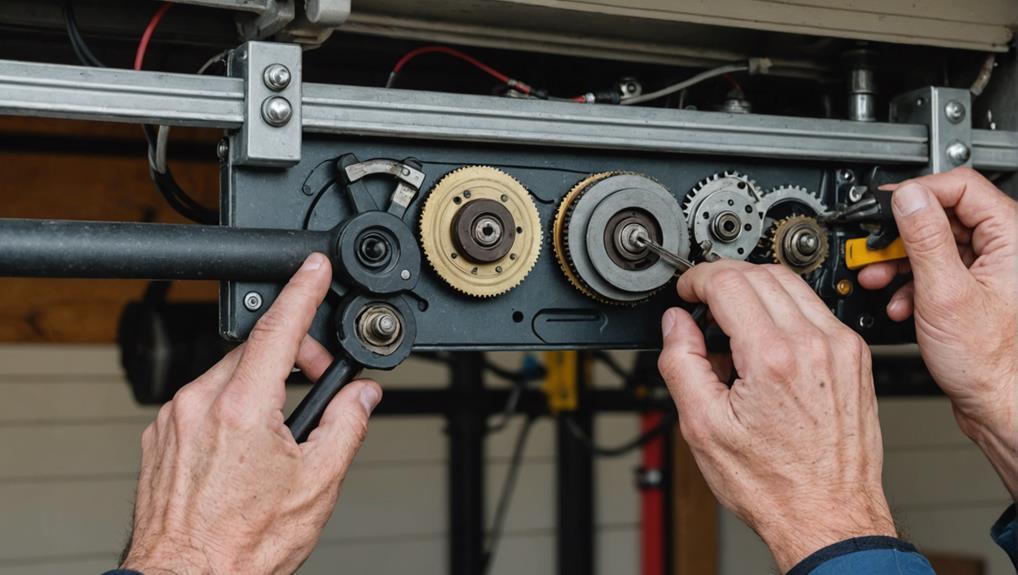To manage your garage door spring repair costs, consider three key strategies. Begin by familiarizing yourself with the two main spring types: torsion and extension. Your choice greatly influences lifespan and repair expenses. Second, contemplate whether DIY or professional repair fits your skill-set and budget better; remember, upfront cost savings from DIY could be offset by further damages if not done correctly. Finally, don't underestimate the value of regular inspection, lubrication, cleaning, and balance testing to minimize wear and tear. Embracing these elements will allow you to navigate the complexities of garage door spring repair, smarter and more efficiently.
Understanding Garage Door Spring Types
In the world of garage door maintenance, understanding the different types of garage door springs is important. You're likely to encounter two main types: torsion and extension springs. Each type has its unique set of characteristics, advantages, and drawbacks, and knowing these can help you make informed decisions when it comes to maintenance or replacement.
Torsion springs are typically mounted above the garage door, wrapping around a metal rod. When you open the door, these springs unwind, providing the force needed to lift it. They're known for their durability and even distribution of weight, leading to smoother operation.
On the other hand, extension springs stretch and contract. They're mounted on either side of the door, extending outwards when the door is lowered. While often cheaper than torsion springs, they've a shorter lifespan and can cause uneven weight distribution.
Lifespan comparison between the two is essential. Torsion springs generally last between 15,000-20,000 cycles, while extension springs have a lifespan of about 10,000 cycles. Ultimately, the choice between torsion vs extension will depend on factors like your garage door's weight, the headroom available, and your budget.
DIY Vs Professional Repair Costs
Often, you might be torn between the decision to DIY or hire a professional for your garage door spring repair. Each option comes with its own set of advantages and potential pitfalls. Let's explore these to help you make an informed choice.
DIY repairs can lead to significant savings. By taking the job into your own hands, you eliminate labor costs which typically make up a large portion of professional repair bills. However, this assumes you have the necessary knowledge, tools, and confidence to tackle the job. Without these, you risk causing further damage or potentially injuring yourself, which could result in higher costs down the line.
On the other hand, relying on professional expertise guarantees the job is done right the first time. Trained professionals can quickly diagnose the issue, and they've the specialized tools and experience to fix it efficiently. Although you'll pay more upfront, you're less likely to encounter recurring issues or additional damages due to improper repair.
Regular Maintenance to Reduce Costs
While determining whether to go the DIY route or hire a professional for garage door spring repair is important, equally valuable is embracing regular maintenance practices to reduce costs. Regular upkeep is a preventative measure that can greatly contribute to cost savings in the long run.
Routine inspections allow you to catch minor issues before they escalate into notable problems requiring costly repairs. For instance, frequent lubrication of moving parts can prevent wear and tear, reducing the likelihood of spring breakage.
Regular cleaning and checking for rust can also prevent corrosion, another common cause of spring failure.
Moreover, it's important to regularly test the balance of your garage door. If it's off-balance, it can put undue stress on the springs, leading to premature failure.
You can do this by disconnecting the opener and manually lifting the door halfway. If it doesn't stay put, the springs may need adjustment—a task best left to professionals for safety reasons.
Conclusion
To sum up, understanding your garage door spring type can make a huge difference. Weigh the costs between a DIY fix and professional repair, keeping in mind the potential risks. Remember, regular maintenance can keep those pesky repair costs at bay. Picture your garage door, a steadfast guardian of your home, operating smoothly. It's not just about saving money, it's about ensuring a sense of security and peace of mind. Be smart, be proactive, and keep that garage door in top shape.

